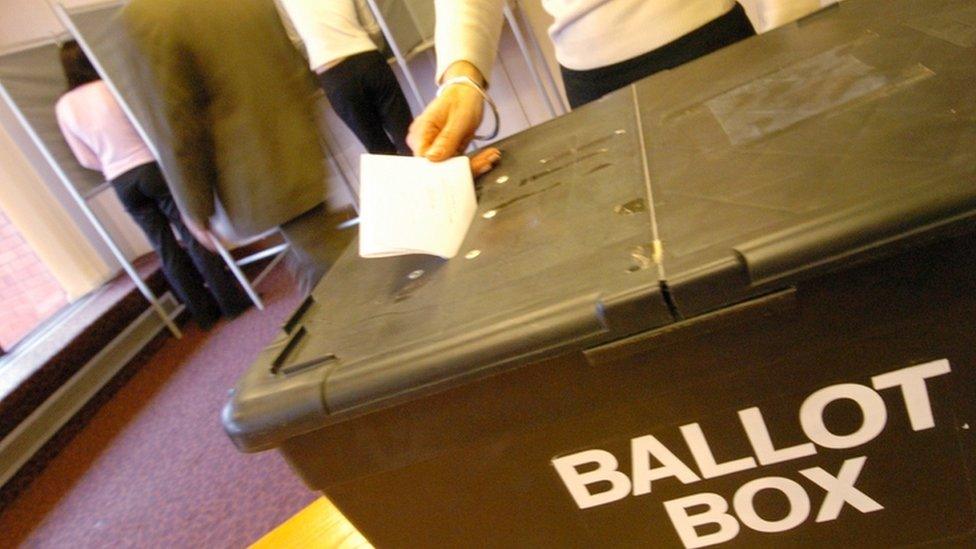Scottish local elections: Who's standing? Who can vote? And much more....
- Published

Scotland's local authority elections will be held on Thursday 4 May
Scotland will go to the polls again for local authority elections on Thursday 4 May. Here is a breakdown of everything you need to know ahead of the vote.

Timetable
The last Scottish council election was held in 2012. Normally seats are contested every four years but this election was delayed by one year to avoid a clash with the Scottish Parliament election in 2016.
If you are not already registered to vote in this forthcoming local council election you need to register, external by midnight on Monday 17 April. Here is a list of deadlines:
the deadline for applying for a postal vote is 17:00 on Tuesday 18 April
the deadline for applying for a proxy vote, except in an emergency, is 17:00 on Tuesday 25 April
the deadline for applying for a proxy vote as a result of an emergency is 17:00 on Thursday 4 May.
the last time an elector can apply for a replacement for a spoilt or lost postal vote is 17:00 on Thursday 4 May.
All polling stations are open between 07:00 and 22:00 on Thursday 4 May. If you arrive at a polling station by 22:00 and there is a queue you will still be able to vote.
Votes will be counted for all areas between 08:00 and 09:30 on Friday 5 May.

Who's Standing?

There are 32 local authorities, external in Scotland with a total of 1,227 seats.
Each council has a range of responsibilities, including local education, social work, local roads, libraries and bin collection.
Currently Labour have majority administrations in Glasgow, North Lanarkshire, South Lanarkshire, Renfrewshire and West Dunbartonshire.
The SNP have a majority administration in both Dundee and Angus.
Independents have majority administrations in Shetland, Orkney and Comhairle nan Eilean Siar.
A full list of who forms each administration for every local authority can be found here, external.
Of the 2,572 candidates standing, just 30% are women according to campaign group Women 5050.
Following the SNP's performance in the 2016 Scottish elections, a key question will be whether the party can also erode Labour's majority administrations at local authority level.
Here are a list of candidates, external for each local authority where available.
Aberdeen City Council, external
Aberdeenshire Council, external
Argyll and Bute Council, external
The City of Edinburgh Council, external
Clackmannanshire Council, external
Comhairle nan Eilean Siar, external
Dumfries and Galloway Council, external
East Ayrshire Council, external
East Dunbartonshire Council, external
East Lothian Council, external
East Renfrewshire Council, external
Glasgow City Council, external
North Ayrshire Council, external
North Lanarkshire Council, external
Orkney Islands Council, external
Perth and Kinross Council, external
Renfrewshire Council, external
Scottish Borders Council, external
Shetland Islands Council, external
South Ayrshire Council, external
South Lanarkshire Council, external

The Voting System
The Single Transferrable Vote , external(STV) system is used for local council elections in Scotland. This is a form of proportional representation which means councillors are elected in multi-member wards and voters rank the candidates in order of preference. The STV system has historically resulted in some councils being run by coalitions.
With the STV system, voters are asked to rank candidates in order of preference.
You can indicate your preferred candidate by marking a '1' in the box next to your first choice.
If you wish you can mark a '2' next to your second preference, a '3' next to your third and so on.
There is no minimum or maximum number of preferences that can be marked. You just carry on until you no longer wish to express a preference.
Unlike the more well-known first-past-the-post system, candidates don't need a majority or more votes than their competitors to be elected, just a known or share, or "quota".
The votes are counted in stages. During the first stage only the first preferences are counted and anyone who reaches the quota is elected.
Leftover votes are then transferred to the second preference, and if not enough candidates hit the quota, the one with the lowest number of votes is eliminated and all their votes are passed to the next preference on the ballot papers.
The process is repeated until three or four candidates have been elected.
STV also means that the parties have to think about how many candidates to put up in each ward. The influence of a vote may be limited if a person only votes for a few candidates.

Who can vote?
You can vote if you are registered in the local government area where the election is taking place. You must be:
aged 16 or over on polling day
a British citizen
an Irish, EU or qualifying Commonwealth citizen
British citizens living overseas who are registered as overseas electors cannot vote in local government elections. Armed service voters stationed abroad are still eligible to vote in local government elections provided they are registered to vote.